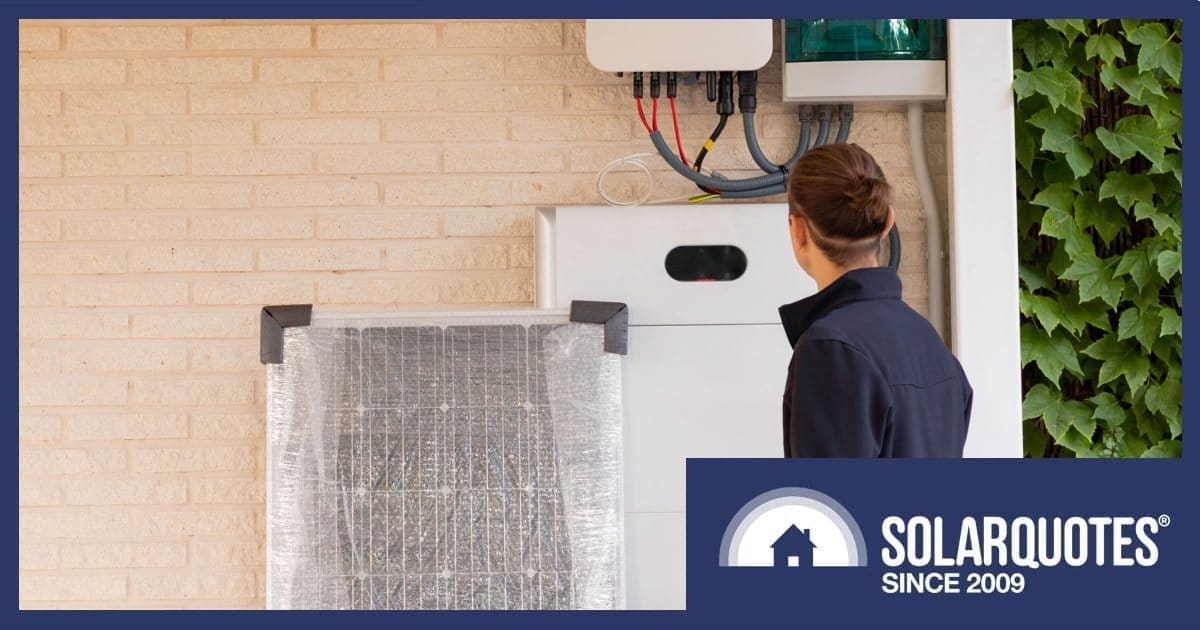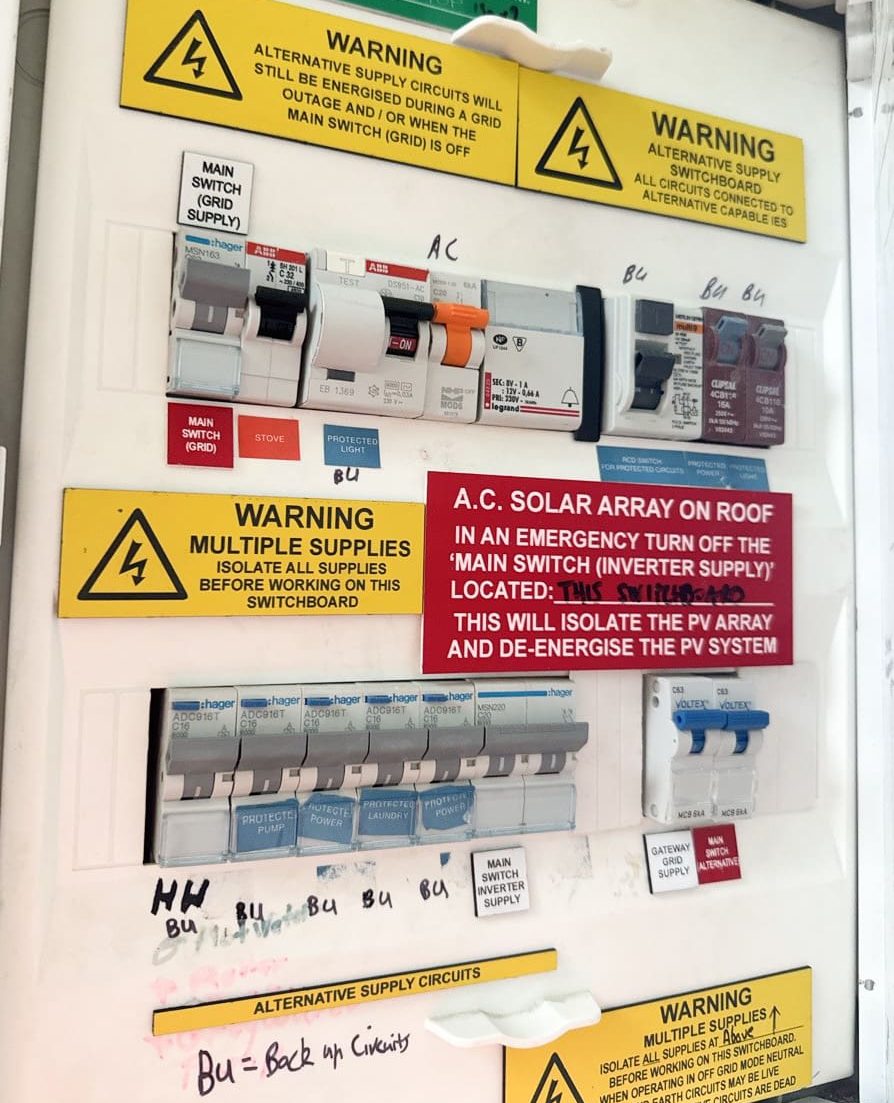
What Should A Battery Installer Tell You Before Leaving?
You’re the one living with this system — you deserve to know how it works.
A proper handover includes:
– How to shut the system down safely (for emergency or maintenance);
– How to monitor performance;
– What different alerts or lights mean;
– What parts of your home are covered by the battery (especially alternative supply/backup circuits);
– Who to contact for service, warranty, or technical issues.
It shouldn’t be overwhelming — but it should be thorough. No assumptions. No jargon. Just practical information.
What If You Already Have Solar?
Many battery installs are add-ons to existing solar systems, which present an additional set of handover requirements.
Unfortunately, I regularly attend inspections where the homeowner hasn’t been told:
– What has changed;
– What has stayed the same;
– Whether their old solar gear is still compliant;
– How the new system actually interacts with what was already there.
That’s not good enough.
Whether you’re just adding a battery or overhauling the lot, you should understand:
– What was upgraded (and why);
– What has stayed in place;
– How your battery and solar systems now function together;
– And what to expect in terms of performance, monitoring, and shutdown procedures.
If your installer can’t explain that clearly, they might be in over their head.
Backup / Alternative Supply Circuits: You Need to Know What’s Covered

Circuits which are energised in a black out must be clearly labelled “Alternative Supply”.
When I ask homeowners whether they have backup (or alternative supply) circuits, a very common response is: “I’m not sure.”
That’s a red flag.
If your battery is configured to provide power during a blackout, you need to know:
– Which circuits will stay powered;
– Where they’re located;
– How to identify them during an outage.
Commissioning: More Than Just Powering Up
Proper commissioning is critical. Unfortunately, it’s one of the steps that’s skipped most often. Make sure that:
– The battery is tested under load conditions;
– Battery and inverter communication is checked;
– Monitoring portals (app, desktop, or on-device screens) are activated and functional;
– Alternative supply circuits (commonly referred to as backup circuits) are verified, labelled, and tested;
– Parameters are configured — such as charge/discharge limits, and whether the battery can be force-charged or force-discharged;
– The system is confirmed to operate safely in alternative supply mode (when the grid goes down).
If these steps haven’t been completed properly, your battery may not operate safely or as expected.
Customer Handover: Not Just a USB and a Wave Goodbye
Whether your installation is inspected or not, your expectations as a customer should remain high.
Your battery system should be:
– Compliant;
– Commissioned properly;
– Integrated safely with any existing solar;
– Clearly explained to you;
– Safe, clean, and ready for long-term use.
If something seems off — or the installer rushes through the handover without explaining things properly — ask questions.
And if an inspector turns up after the job’s done? We’re not here to make life hard. We’re there to make sure everything’s been done properly, so your system doesn’t just look the part, but actually works the way it should.
This is the second in a two part series. You can read the first part on how to inspect your installer’s work here.

 RSS - Posts
RSS - Posts



I dont think we have inspectors here in Queensland, at least I, and no one else I know with solar has ever mentioned getting a visit.
Here’s a battery backup question. During the night I can run my AC using the battery but in a blackout situation no AC.
Any ideas?
Hi Chris,
It’s about capacity. Air conditioning is usually a hungry appliance which will overwhelm a modest inverter, so most installers will quite sensibly exclude AC, stove or other big heavy loads from the backup circuit.
Ah, that’d be the Insufficient-Battery-n-Inverter trap, I guess. 😉
If you air cons are big enough to run their own breakers / cabling, they are generally left off the backup.
Our bedroom aircons will run on our backup, but our two 8kw units for the main living areas are on their own circuits and are not on the backup.
Always a good idea to have at least one aircon on the backup if you live in the north where storms are prevalent. Stinking hot night with no aircon after storms have taken out the mains power are not uncommon.
Hi Anthony and Andrew
Thanks for your replies.
Cheers
Chris
We have random inspections, not mandatory ones for each job
If I’m installing 29 jinko 510wt panels will a 10kw growatt battery be suitable
Also if ther is a power outage will the battery kick in
Thank you
The average gov’t subsidised battery install, 1000 per day going in, is 20 kWh.
Anything less will only help a bit with cooking in the evening peak, not reliably run a substantial aircon all night – multi-room ducted, no chance.
E.g. If my single-room 7 kW (thermal) aircon uses about 1 kW after the 35 sq m lounge has cooled, then 10 kWh could nearly make it through the night – so long as you turn off the fridge, freezer, and all lights, till morning.
Given your aircon scenario, and high altitude air temperatures above Antarctica 35°C (yes, thirty-five) above normal now, I’d prepare for summer with a 30 kWh battery, if the budget permits – OR put in 20 kWh of stackable battery, so another e.g. 8 kWh can be plonked on top when needed.
The Tiny-Battery Trap is most punishing if it is not plug-in expandable, e.g. stackable. That’s costly later. Of course, the battery inverter(s) must also be big enough. (My 12 kW suffices for my night loads, 5 or 6 kW won’t with aircon.)
Your battery will be charged very quickly by that array (approx 16kw), I had a 12.8kWh battery and my 10kw array had it charged from around 20% to full by 9:30 am most days.
I have since upgraded to 19.2kWh in the battery to make it easier to navigate overcast days and hot nights where i want to run my large air cons for a few hours before going to bed.
You could upsize your battery quite a bit if you wanted to. My father has 6kw of panels and they easily keeps his 10kWh battery charged.
As for backup, you will have to ask the installer, it depends on the model of your inverter and how it needs to be wired. But if you specify you want automatic backup when the power fails they should be able to quote you for that. If you forgot to ask, just get him to give you a second quote.
Just has a battery system installed on Monday and I only checked that the solar system was generating power and not the individual microinverters. Turns out, since the battery install 10 of my 32 microinverters have stopped production. Enphase support says the affected devices are getting zero AC voltage. Waiting for the battery installers to come back but thye are likley booked out with new installs. Obviously can’t reach out to my previous solar installers since it was working before and the battery install broke it.